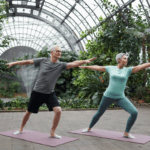Coming Soon: E-book about Kundalini Yoga - Sign up here to be among the first to get it!
Yoga, the best runner’s ally
Welcome to the world of running, where every stride counts towards achieving your personal best. But, as any seasoned runner knows, the key to an effective run lies not just in the run itself, but in the quality of the warm-up. Yoga for runners can help increase flexibility, strength, and mental focus, becoming an invaluable asset to your running regimen.
In this article, we will explore a unique pre run yoga sequence specifically designed for runners. This isn’t just any routine; it’s a targeted approach to warm up muscles, enhance the range of motion, and prepare the mind for the journey ahead. Whether it’s a casual jog or preparing for a marathon, incorporating yoga for runners into your warm-up regimen can make a significant difference in performance and overall running experience.
Stay tuned as we dive into a series of yoga stretches for runners, each chosen for its ability to target key muscle groups used in running. From improving your stride to preventing common injuries, this yoga routine for runners is a stepping stone to a more fulfilling and injury-free running journey.
Runners Common Problems
Runners often experience common pains and challenges that can affect their performance and overall enjoyment of the sport. Understanding these pain points is crucial for tailoring solutions, such as yoga sequences, to meet their specific needs. Here are some of the most common issues runners face:
Knee Pain (Runner’s Knee)
This is one of the most frequent complaints among runners. It’s often caused by overuse, misalignment, and imbalances in the strength and flexibility of leg muscles. If you want to learn more about this check out this article “Ease Your Joints: Effective Yoga for Knee Pain Relief.”
Shin Splints
This pain along the shinbone is common, particularly in new runners or those returning after an extended break. It’s usually due to sudden increases in training intensity or volume.
Achilles Tendinitis
This is an inflammation of the Achilles tendon, the band of tissue connecting calf muscles at the back of the lower leg to your heel bone. It can be caused by overuse, tight calf muscles, or improper footwear.
Plantar Fasciitis
This involves pain in the bottom of the foot, often near the heel. It’s caused by inflammation of the plantar fascia, a thick band of tissue running across the bottom of the foot.
Iliotibial Band Syndrome (ITBS)
The iliotibial band runs outside the thigh, from the hip to the knee. ITBS is a common overuse injury causing pain along this band, especially near the knee.
Muscle Imbalances and Weaknesses
Runners often have stronger quads compared to their hamstrings and glutes. These imbalances can lead to injuries and inefficient running form.
Lower Back Pain
This can be due to tight hip flexors, weak core muscles, or poor running posture.
Hamstring Issues
Tight or weak hamstrings are a common problem, leading to strains and discomfort. If you are looking for a tailored post-run yoga sequence for lower back pain, click here.
Mental Fatigue and Burnout
Running is as much a mental challenge as a physical one. Mental fatigue, lack of motivation, or burnout can be significant hurdles.
A great way to increase mental focus and resilience for runners is through Kundalini Yoga or Pranayama.
Need for Improved Flexibility and Mobility
Runners often face challenges with flexibility and mobility, which can impact their running stride and increase the risk of injuries. Like any other skill, flexibility requires consistent training. To enhance flexibility, it’s best to incorporate a bit of stretching into your daily routine. Discover a yoga sequence tailored for runners’ flexibility on our website.
Desire for Enhanced Performance
Runners often seek ways to improve their speed, endurance, and overall performance.
Recovery and Injury Prevention
For those who are training for marathons or frequently engaging in long-distance running, adopting effective recovery strategies and focusing on injury prevention is essential. Incorporating yoga for runners into your regimen can be a game-changer in this regard.
Targeted yoga sequences can address these common issues, offering a plethora of advantages that include not only increased flexibility but also stronger, more balanced muscle groups, sharpened mental focus, and superior injury prevention. This highlights how yoga for runners is not only beneficial but can be an excellent addition to a runner’s training, addressing both the physical and mental demands of the sport.
Yoga’s Benefits for Runners
Integrating yoga for runners and stretching into a runner’s warm-up routine can lead to numerous benefits, as supported by various studies. A consistent yoga practice, especially as part of a long-term warm-up strategy, has been shown to significantly enhance lower body flexibility and speed over longer distances, such as the 800m run, while also positively influencing balance, making running and yoga a powerful combination [source].
Runners who are less naturally flexible may find that incorporating yoga for runners into their stretching routine can be particularly advantageous, leading to a more efficient and economical running style [source].
Moreover, including both static and dynamic stretching in the warm-up, as practiced in yoga for runners, not only improves running economy but also lowers the perception of effort, which can help increase endurance performance [source].
Post-run yoga stretches are crucial for recovery, as they assist in restoring strength and range of motion while also helping to alleviate delayed onset muscle soreness [source]. Furthermore, consistent stretching has been linked to a lower risk of musculotendinous injuries, crucial for running-based sports [source].
All in all, we can summarise that yoga practice, often questioned as ‘is yoga good for runners’, indeed proves beneficial for runners for the following reasons:
Improved Flexibility for Less Flexible Runners
One study found that runners with less flexibility gained greater benefits from stretching than those with normal flexibility. It suggests that less flexible runners should aim for optimal flexibility to achieve a more economical run. Imagine including a few yoga poses in your routine and increasing your flexibility, wouldn’t you enjoy running faster and longer easily?
Enhanced Running Economy and Reduced Effort Perception
Another study demonstrated that incorporating static and dynamic stretching (SS and DS) in the warm-up improved running economy and decreased the perception of effort during a running-until-exhaustion test. This indicates the positive impact of stretching (which could also be in the form of a few yoga poses) on endurance performance.
Improved Recovery and Reduced Muscle Soreness
Post-exercise stretching, particularly yoga for runners, is commonly recommended for improving recovery of strength and range of motion, as well as diminishing delayed onset muscular soreness (DOMS) following physical exertion. If you’re eager to learn more about what type of practice you can incorporate in your post-run, check my article.Yoga for Runner: Recover Faster.
Reduction in Musculotendinous Injury Risk
Both pre-exercise and chronic stretching, including yoga for runners, have been shown to reduce the incidence of musculotendinous injuries in running-based sports. This could be due to the increased force available at longer muscle lengths or reduced active musculotendinous stiffness.
Positive Outcomes from Flexibility Training
In studies where flexibility training was part of the exercise program, stretching exercises showed positive outcomes, further emphasizing the value of practicing yoga and stretching in a runner’s routine.
These studies collectively underline the importance of incorporating yoga for runners in a runner’s routine, as a warm-up and a cool-down, not just for enhancing performance but also for injury prevention, recovery, and overall physical well-being.
12 Yoga Poses for Runners
Downward-Facing Dog (Adho Mukha Svanasana)
Pose Basic Instructions: Begin on your hands and knees. Lift your hips up and back, straightening your legs and arms—a fundamental yoga for runners pose. Keep your head between your arms.
Breathing: Stay here for a few breaths.
Variations: Pedal your feet to deepen the stretch in each leg. If fully extending the legs is difficult, keep a slight bend in the knees. Use yoga blocks under your hands for added support.
Benefits: This pose stretches the hamstrings, calves, and spine; and strengthens arms and legs.
Low Lunge (Anjaneyasana)
Pose Basic Instructions: From a standing position, step one foot back into a lunge, lowering your back knee to the ground—a common yoga for runners position. Raise your arms overhead. Keep your shoulder relaxed and back straight.
Breathing: Stay here for a few breaths, then release the pose and switch legs.
Variations: To enhance your yoga for runners routine, consider adding a gentle backbend or twist if you’re up for a challenge. If that’s already strenuous, support yourself by placing your hands on your front thigh instead of extending them overhead. For additional comfort, especially during your yoga for runners practice, use a cushion under the back knee.
Benefits: Opens the hips, and stretches the hamstrings and quads.
Crescent Lunge (Ashta Chandrasana)
Pose Basic Instructions: This pose is a variation of the low lunge often incorporated in yoga for runners but with the back knee elevated. Ensure your front knee is aligned over the ankle and lift your arms to complete the posture.
Breathing: Stay here for a few breaths, then release the pose and switch legs.
Variations: Incorporate this modification into your yoga for runners sequence by lowering the back knee to the ground if you find balancing difficult. It’s best to keep your hands on your hips rather than lifting them.
Benefits: This pose strengthens the legs, and stretches the hip flexors and chest.
Standing Forward Fold (Uttanasana)
Pose Basic Instructions: Stand with feet hip-width apart, and as you exhale, hinge at the hips, not the waist, to bend forward—a fundamental movement in yoga for runners. Aim to touch the ground or your ankles.
Breathing: While practicing yoga for runners, breathe deeply and remain in this position for a few breaths, allowing yourself to feel the stretch in your hamstrings and to relax your upper body.
Variations: For a variation suitable for yoga for runners, clasp your elbows or opt for a ragdoll variation. To reduce hamstring tension, you can also bend your knees generously. For support, rest your hands on yoga blocks.
Benefits: This yoga pose stretches the hamstrings, calves, and hips; and calms the mind.
Warrior I (Virabhadrasana I)
Pose Basic Instructions: As part of a yoga for runners routine, begin from a standing position, step one foot back, and bend your front knee. Then, raise your arms above your head to enter the pose.
Breathing: Stay here for a few breaths, then release the pose and switch legs.
Variations: To enhance your yoga for runners practice, shorten your stance and maintain a slight bend in the front knee. Place your hands on your hips for stability.
Benefits: Strengthens the legs and arms; stretches the chest and shoulders.
Check out this in-depth post about this pose.
Triangle Pose (Trikonasana)
Pose Basic Instructions: For yoga for runners, adopt a wide-legged stance, turn one foot outward, extend your arms, and hinge at the hip towards your front foot. Lower your hand to your ankle, shin, or the ground, depending on your flexibility.
Breathing: Stay here for a few breaths, then release the pose and switch legs.
Variations: If necessary, slightly bend the front knee, and for additional yoga for runners support, place a yoga block under your bottom hand.
Benefits: This stretches the thighs, knees, and ankles; and strengthens the legs.
Garland Pose (Malasana)
Pose Basic Instructions: Incorporate this yoga for runners squat by bringing your feet as close together as possible, keeping your heels on the ground or using a rolled-up mat for support.
Breathing: Remain in this yoga for runners pose for a few breaths, ensuring your shoulders stay relaxed. Then, gently release the pose.
Variations: If squatting down is challenging, yoga for runners suggests sitting on a block or a bolster. To support your heels if they don’t reach the ground, use a folded mat.
Benefits: This yoga for runners pose is beneficial for opening up the hips and groin; it also stretches the ankles, lower hamstrings, back, and neck.
Pigeon Pose (Eka Pada Rajakapotasana)
Pose Basic Instructions: Incorporating yoga for runners into your routine, start from all fours, bring one knee forward and out to the side, and extend the other leg behind you. As you lower the hips, ensure they are squared forward to maximize the stretch.
Breathing: As part of a yoga for runners practice, stay here for a few breaths with shoulders relaxed. Then, release the pose and switch legs to maintain balance in your stretching.
Variations: For a gentler stretch suitable for yoga for runners, keep the front foot closer to your hip. To further reduce strain, sit on a cushion or folded blanket, elevating the hips for a more comfortable position.
Benefits: This stretches the thighs, groin, back, and psoas.
Cradle Pose (Hindolasana)
Pose Basic Instructions: When practicing yoga for runners, sit with your legs extended in front. Lift your right leg, cradling the lower leg in your arms, and gently rock the leg as if cradling a baby, which can soothe tight muscles.
Breathing: Maintain a yoga for runners sequence by staying here for a few breaths with shoulders relaxed. Afterward, release the pose and switch legs to ensure both sides receive the benefit.
Variations: If holding the leg proves difficult during your yoga for runners session, use a yoga strap around the foot for support. Alternatively, sitting on a chair, gently lift one leg at a time, resting your ankle on the opposite knee, and lean forward slightly to deepen the stretch.
Benefits: Increases hip flexibility and releases tension in the hip and gluteal muscles.
Cat-Cow Stretch (Marjaryasana-Bitilasana)
Pose Basic Instructions: Begin your yoga for runners routine on your hands and knees, inhale as you arch your back (Cow), and exhale as you round your spine (Cat). This movement is an excellent warm-up for the spine and prepares you for more challenging poses.
Breathing: Repeat this for 10 breaths or more as needed.
Variations: Perform the movements gently and slowly, integrating yoga for runners into your routine. If being on hands and knees is uncomfortable, try doing the exercise seated in a chair as an alternative.
Benefits: Increases flexibility of the spine; massages the organs.
Legs-Up-The-Wall Pose (Viparita Karani)
Pose Basic Instructions: For a beneficial yoga for runners pose, sit close to a wall, then swing your legs up against it. Your body should form an L-shape, which is excellent for recovery.
Breathing: Stay here for a few breaths, body relaxed.
Variations: Place a bolster or cushion under your hips for support, a common yoga for runners modification. Bend the knees and place your feet against the wall if extending the legs is too intense.
Benefits: Relieves tired leg muscles; helps with recovery and relaxation.
Remember to listen to your body and modify these yoga poses for runners as needed. They should help you warm up effectively, reducing the risk of injury and improving your running performance.
Conclusion
In conclusion, integrating yoga for runners into a runner’s warm-up routine offers several benefits that extend beyond mere physical flexibility. The yoga poses we’ve explored cater to runners of all levels, making this practice accessible and inclusive. From enhancing lower body flexibility to warming up the spine, this short yoga sequence is designed to prepare the body and mind for the upcoming run.
By practicing these yoga for runner poses regularly before running, athletes can not only boost their performance but also prevent common running injuries. The focus on breath and movement inherent in yoga practice also aids in mental preparation, allowing runners to achieve a focused and mindful state, crucial for endurance sports.
For those interested in the holistic benefits of yoga for runners, our upcoming article will delve deeper into how this practice can enhance your running experience.” Yoga for Runners: Yoga Poses to Cool Down and Recover Faster,” where we look into yoga poses specifically designed for a post-run cooldown routine. This post will guide runners through a series of poses that will help speed up recovery, alleviate muscle soreness, and enhance overall well-being after a run.
Together, these articles and yoga sequences form a comprehensive approach to incorporating yoga for runners into their regimen, ensuring a well-rounded and injury-free running experience. Stay tuned for more insights and guidance on how yoga can enhance your running journey!



